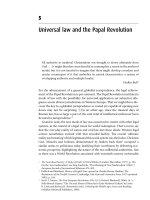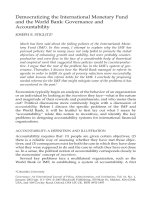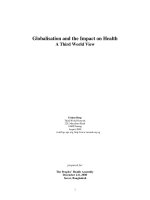Globalisation and the World Revolution
Bạn đang xem bản rút gọn của tài liệu. Xem và tải ngay bản đầy đủ của tài liệu tại đây (163.27 KB, 27 trang )
2
Globalisation and the World Revolution
Te chnology is a key element of globalisation. The effects of globalisation are fre-
quently explored in the context of sovereignty. Technology therefore has con-
stitutional implications. Perceived legal correlates to globalisation, such as the
blurring divide between private and public international law through present
constitutional issues associated with competing jurisdictions, legal pluralism,
multinational enterprises and a ‘world society’, are related to the technological
innovation associated with the World Revolution of the two world wars of the
twentieth century. Yet it would be a mistake to assume that these legal develop-
ments are simple reactions to technological and economic forces of globalisa-
tion representing the latest political and economic goals. Far from today’s legal
responses being surface events, deeply layered sediments of legal and political
philosophy and history underlie the topsoil intersections of law and globalisa-
tion. Globalisation and law cannot be understood without delving into the
deeper sediments, pursued in later chapters. In this chapter, the topsoil forma-
tions are first surveyed in order to identify the sites of authority for later
excavation.
The general notion of globalisation as ‘the accelerated interconnections
amongst things that happen in the world’ will be maintained after some inves-
tigation. The terrorist events of ‘September 11’ 2001, in the United States,
confirm this definition. (Within a fortnight, the world aviation industry was
plunged into dire financial circumstances, international tourism reeled and the
insurance industry faced massive losses.) After observing the profound associ-
ated challenges for social time and space in this chapter, a novel model will be
proposed in chapter 3 to complete the outline for a globalist jurisprudence the
subject of part 2. That will in turn enable, in the balance of this book, an appre-
ciation of the nature of legal authority today by reference to the past millen-
nium. Patterns of law and authority from the first half of the second millennium
will be seen to be recurring today. Recognition of these patterns and the assess-
ment of law in different locations and times will be essential to advancing a
general, globalist jurisprudence.
2.1 Grappling with globalisation
2.1.1 Symbols and political change
Before being able to think about something, that thing must have its symbols in
the world.
1
This insight will aid the attempt to define and understand global-
isation. Michael Walzer has argued that the symbolic ‘changes in the way
men conceived the cosmological reference-world’ made possible the political
changes which occurred in the seventeenth century.
2
That is, when the earth was
found not to be the centre of the universe, alternative political ideas emerged
from these new symbols. The notion of a Godly, harmonious, hierarchical body
politic was challenged by the socially contracted state comprising clashing indi-
viduals. What symbols of globalisation preceded the thoughts and ultimate
incarnation of globalisation in our world?
Symbolically, the nation-state has, as its scientific correlates, order, precision
and containment within manageable, territorial bounds, certain of time and
space. That very type of Newtonian science was part of Walzer’s example, in
which territorial, parliamentary government became incipient. As the twenti-
eth century unfolded, certain very different models from the natural sciences
emerged. Einsteinian cosmology posited the relativity of time and space.
According to Albert Einstein, there is no absolute measurement across space:
clocks, for example, will vary according to the speed travelled. Measurement is
localised.
3
Although this has only the most miniscule fractional significance
for any activity on earth, it may have remarkable consequences for philosophy
and, in a less direct way, society. It undermines certainty and increases relativ-
ity, particularly where judgements are concerned. That is, there may be other
ways of looking at things. There may not be one divine set of norms to govern
all people.
Chaos theory provides more useful symbolism. The study of natural phe-
nomena in all their complexity is attempted by chaos theory, unlike classical
science which tends to be reductionist and limiting of its variables. Chaos
theory posits the significant interconnections amongst relatively distant,
minute things that happen in the world.
4
In the common example now
approaching a cliché, a butterfly fluttering its wings in one hemisphere of the
world may have a significant effect in the other hemisphere, by way of snow-
balling weather effects which are initiated by the seemingly minor activity of the
butterfly. Benoit Mandelbrot discovered a mathematical formula in fractal
geometry which underlies chaos theory – positing that randomness produces
26 Towards a Globalist Jurisprudence
111
Langer, Philosophy in a New Key cited in Michael Walzer, ‘On the Role of Symbolism in
Political Thought’ (1967) 82 Political Science Quarterly 191–204, 194.
112
Walzer, ‘Role of Symbolism’, 197.
113
See Boaventura de Sousa Santos, Toward a New Common Sense: Law, Science and Politics in the
Paradigmatic Transition (New York: Routledge, 1995), p. 18.
114
See James Gleick, Chaos: Making a New Science (New York: Penguin, 1987).
recurring patterns, reflected in the related shapes of, for example, a tree, broc-
coli or the coastline viewed from a distance. His formula, in plot form, pro-
duces a psychedelic, paisley-like pattern which, when magnified, discloses at
the edges of the pattern a further paisley-like pattern, within the edges of
the first pattern which decrease in intricacy and complexity with magnifica-
tion and further enquiry. Magnification may be repeated ad infinitum. The
effect is that what appears to be, on the surface, a single unified pattern, con-
tains underneath ever expanding, complex sub-patterns which, when mag-
nified, stabilise into the single pattern, demonstrating complexity within the
singularity.
The simple–complex, general–particular, identical–different paradox
5
of
chaos theory is typical of globalisation studies, particularly by sociologists and
cultural theorists. There is complexity behind the easy assumption that global-
isation is a singular, domineering tendency in an emerging global society of cen-
tralised norms. At the same time, there are universalist themes deriving from all
sorts of social diversities, such as human rights. With this caution in mind, an
attempt to define globalisation may proceed.
2.1.2 History
Literature which explores the notion of globalisation in any depth acknowl-
edges that its origins go way back. Those historical origins and developments
are not, however, globalisation itself – they are factual precursors which enable
the concept of globalisation to be better understood.
Roland Robertson has proposed, in skeletal terms, the phases leading to glob-
alisation. The ‘germinal phase’ lasted from the early fifteenth century to the
mid-eighteenth century, featuring increasing individualism and awareness of
humanity, with the spread of the Gregorian calendar and the heliocentric idea
of the world. The ‘incipient phase’ began in the mid-eighteenth century and
ended in the 1870s. The concept of the unitary state emerged, with standard
citizens and formalised notions of international relations, although there were
problems with non-European societies being admitted to ‘international’
society. The third phase, the ‘take-off phase’, from the 1870s until the mid-
1920s, witnessed the increasing importance of national identity, the inclusion
of some non-European societies in ‘international’ society, and, perhaps most
significantly, the ‘[v]ery sharp increase in the number and speed of global forms
of communication’ and the development of global competitions such as the
Olympics. From the early 1920s to the mid-1960s, the fourth ‘struggle for hege-
mony’ phase saw disputes and wars about national ideals formalised from the
previous phase. Humanity was confronted with the Holocaust, atomic bomb
27 Globalisation and the World Revolution
115
This is a theme of Fredric Jameson, ‘Notes on Globalization as a Philosophical Issue’ in
Fredric Jameson and Masao Miyoshi (eds.), The Cultures of Globalization (Durham, NC: Duke
University Press, 1998).
and United Nations.
6
Finally, there is the ‘uncertainty phase’ from the 1960s,
which brings us to the present, discussed in the next section.
Commerce-led cultural interconnection has been a characteristic of world
and not just Western history since very early times. In the eighteenth and early
nineteenth centuries, it received a boost with the Industrial Revolution and the
free thinking of British economists such as Adam Smith and David Ricardo. The
separation at that time of the economic and political spheres, leaving the market
more to its own devices, in effect de-moralised production.
7
The effect on pro-
ductivity was tremendous, illustrated by the hegemonic success of England in
the following century
8
as the premier exemplar of this approach to political
economy. Here, most likely, are to be found the profound sources of what is
today termed ‘globalisation’. Although the world economy had been becoming
noticeably more integrated from the sixteenth century onwards, it was not until
the nineteenth century that world prices began to converge – a truer sign of
interconnection, showing that opportunities for profits around the world were
being exploited.
9
It was a significant century for economic interconnection.
Migration back then was far greater,
10
moving people into new economies.
Indeed, by 1996, world trade as a share of world production was not much
bigger than it had been at the end of the nineteenth century.
11
Real time infor-
mation sharing was occurring between financial markets,
12
although, of course,
it was not popularly accessible as it is today via the internet. On balance, there
is today, however, an undeniably heightened presence of interconnection in the
market and cause and effect consequences, for example in interest rate res-
ponses, means of production, macroeconomic policies and growth in develop-
ing countries.
In the field of legal theory, international law is the most immediate place to
look for the impact of globalisation, being concerned with ‘inter-national’ legal
28 Towards a Globalist Jurisprudence
116
Roland Robertson, ‘Mapping the Global Condition: Globalization as the Central Concept’
in Mike Featherstone (ed.), Global Culture: Nationalism, Globalization and Modernity
(London: Sage, 1990 reprinted 1996), pp. 26–7. Under a title which could have belonged
to our time, the Fabian Society in 1926 sponsored a series of lectures called ‘The Shrinking
World: Dangers and Possibilities’: see Arnold Toynbee, Civilization on Trial (Oxford: Oxford
University Press, 1948), p. 97.
7
See ch. 8, section 8.3, pp. 177–8 below.
118
See Paul Kennedy, The Rise and Fall of the Great Powers: Economic Change and Military
Conflict from 1500 to 2000 (London: Unwin Hyman, 1988), pp. 151–8; Martin Daunton,
‘Britain and Globalisation Since 1850: I. Creating a Global Order, 1850–1914’ (2006) 16
Transactions of the Royal Historical Society 1–38.
119
See Kevin O’Rourke and Jeffrey Williamson, ‘After Columbus: Explaining the Global Trade
Boom, 1500–1800’ (March 2001) NBER Working Paper No. W8186.
110
See David Held and Anthony McGrew, Globalization/Anti-Globalization (Cambridge: Polity
Press, 2002), p. 39.
111
Paul R. Krugman, Pop Internationalism (Cambridge, MA: MIT Press, 1996), p. 212.
112
Paul Hirst and Grahame Thompson, Globalization in Question: The International Economy
and the Possibilities of Governance (Cambridge: Polity Press, 2nd edn, 1999), p. 9. In 1910,
‘international investment as a percentage of total investment was higher than at any other
time’: Samuel Huntington, The Clash of Civilizations and the Remaking of World Order (New
York: Simon & Schuster, 1996), p. 52.
matters as the word, invented by Jeremy Bentham at the end of the eighteenth
century, suggests. It was not until the mid-twentieth century that this notion
began to be modified with persuasiveness.
13
Hans Kelsen was the only major
legal positivist to see international law and national municipal law as part of a
unity: he maintained that the basic foundational norm (Grundnorm) which
gave all law its constitutional validity was from international law.
14
For Kelsen,
the international capacity to invoke sanctions was becoming more centralised
in the manner this capacity had developed centuries earlier in national legal
systems.
15
In anticipation of the ‘world society’ (as opposed to the international
society of sovereign states), Hersch Lauterpacht contended that international
law had to modify the sovereignty of the state so that the sovereignty of the
person could be re-established in situations of abuse.
16
Sociology furthers the idea, in a more thoroughgoing way, that comparative
studies of the nation-state are the appropriate places to look for the conceptual
origins of globalisation. Indeed, sociology is perhaps the most illuminating dis-
cipline for locating the emergence of globalisation as a concept in human con-
sciousness. For a century, critiques of modernisation, notably those of Karl
Marx, had tended to deal with societies (more than just their law) by using a
comparative, mainly national methodology, albeit in a way which sought to
draw out universal principles. That is, comparisons were made between soci-
eties against a Western standard. Yet it was not until the 1970s that these soci-
eties began to be considered as part of an overall system,
17
clearing a path for
concerns about globalisation to permeate and transcend national boundaries as
they do now.
2.1.3 Definition and context
In the 1990s, globalisation entered popular culture, if usage of the word in a
major Sydney tabloid is any guide. In 1987, the word ‘globalisation’ appeared
four times, six times in 1988 and fewer than twenty times a year up to 1993;
29 Globalisation and the World Revolution
113
Numerous utopian proposals had nonetheless found their way into the history of
international relations and law, surveyed where they occur in the chronological developments
mapped in parts 2, 3 and 4 of this book.
114
See Danilo Zolo, ‘Hans Kelsen: International Peace Through International Law’ (1998) 9
European Journal of International Law 306–24.
115
See Hedley Bull, ‘Hans Kelsen and International Law’ in Richard Tur and William Twining
(eds.), Essays on Kelsen (Oxford: Clarendon Press, 1986), p. 170.
116
See Hersch Lauterpacht, International Law and Human Rights (London: Stevens & Sons,
1950). Other modern writings to this end, prior to consciousness of ‘globalisation’, include
C. Wilfred Jenks, The Common Law of Mankind (London: Stevens, 1958); Julius Stone, Of Law
and Nations: Between Power Politics and Human Hopes (Buffalo: W. S. Hein, 1974), ch. 1. On
the late nineteenth-century capture of preliminary human rights in international law by
Pasquale Fiore, see Martti Koskenniemi, The Gentle Civilizer of Nations: The Rise and Fall of
International Law 1870–1960 (Cambridge: Cambridge University Press, 2001), pp. 54–7.
117
See Roland Robertson, Globalization: Social Theory and Global Culture (London: Sage
Publications, 1992 reprinted 1998), pp. 12–15, discussing Wallerstein’s ‘world-systems
theory’.
growing to 143 times in 1997, 260 in 1998, 280 in 1999, 355 in 2000 and 373 by
early September 2001.
18
Around 1996, William Twining ran searches for the words ‘global’ and ‘glob-
alization’ in a library catalogue. After scanning some 250 titles, his synthesis of
a definition of globalisation is useful. He uses the word ‘globalization’ ‘to refer
to those processes which tend to create and consolidate a world economy, a
single ecological system, and a complex network of communications that covers
the whole globe, even if it does not penetrate to every part of it’
19
[my italics].
Note the characterisation of this phenomenon as a world undertaking, single yet
complex. This reinforces the paradoxical, chaos theory nature of the phenome-
non, in less abstract terms than another pithy definition – ‘the compression of
the world and the intensification of consciousness of the world as a whole’
20
–
by Roland Robertson. Anthony Giddens defines globalisation as ‘the intensifi-
cation of worldwide social relations which link distant localities in such a way
that local happenings are shaped by events occurring many miles away and vice
versa’,
21
emphasising the technological feats of communications and travel. The
more specific that definitions of globalisation are, the more simplistic and
preclusive they become by virtue of their focus.
22
A mosaic survey of associations will crystallise the most important of the
many inputs which evoke the complex concept of globalisation. Robertson,
continuing his sketch of historical phases of globalisation,
23
writes of the ‘uncer-
tainty phase’ of globalisation, referring to technological, world society and indi-
vidual issues. Technologically, he lists the moon landing, nuclear weapons and
global media. More socially, he lists the heightening of global consciousness in
the late 1960s and the inclusion of the Third World, civil rights, interest in world
civil society and world citizenship, the increase in the number of global institu-
tions and movements, social issues of multiculturality and polyethnicity, and
individuals complicated by gender, ethnic and racial considerations.
24
Sensitive to local diversities and identities, Boaventura de Sousa Santos writes
that:
the globalization process is connected to other transformations in the world
system which are nonetheless irreducible to it, such as growing world-level
inequality, population explosion, environmental catastrophe, proliferation of
weapons of mass destruction, formal democracy as a political condition for inter-
national assistance to peripheral and semiperipheral countries and so on.
25
30 Towards a Globalist Jurisprudence
118
Vic Caroll, ‘What if . . . free trade had won in 1901’, Sydney Morning Herald, 5 September 2001.
119
William Twining, ‘Globalization and Legal Theory: Some Local Implications’ (1996) 49
Current Legal Problems 1–42, 2.
20
Robertson, Globalization p. 8.
121
Anthony Giddens, Sociology cited in Boaventura de Sousa Santos, Toward a New Legal Common
Sense: Law, Globalization and Emancipation (London: Butterworths, 2nd edn 2002), p. 165.
1
22
Definitions abound, particularly in the social and cultural studies spheres: see generally, Frank
Lechner and John Boli (eds.), The Globalization Reader (Oxford: Blackwell Publishers, 2nd
edn 2004).
23
His sketch to this point was outlined in section 2.1.2, pp. 27–8 above.
1
24
Robertson, ‘Mapping the Global Condition’, p. 27.
1
25
Santos, New Legal Common Sense, pp. 166–7.
Globalisation should be thought about in general terms to appreciate it as a
process, not a thing, and to embrace the variety of events and occurrences which
produce the concept of globalisation in our consciousness. Globalisation can be
thought about as much more than just an economic concept. Former World
Bank Chief Economist Joseph Stiglitz defines globalisation as ‘the removal of
barriers to free trade and the closer integration of national economies’, brought
about by ‘the enormous reduction of costs of transportation and communica-
tion accompanied by new cross-border institutions’.
26
Whilst many writers treat
globalisation in those economic terms, many including myself do not embrace
such limitations. Such matters must be clarified at the outset of any conversa-
tion about globalisation, to avoid semantic misunderstandings.
2.1.4 Operation
Who is doing what to whom under conditions of globalisation? Take the world-
wide American icon of jeans. The name ‘jeans’ comes from the French name for
Genoa, ‘Gènes’. They are made of denim, derived from a tough blue sailcloth,
called Serge de Nîmes, woven in the French town. Levi Strauss, a Bavarian, emi-
grated to New York and supplied prospectors in the 1860s with jeans.
27
Who is
doing what to whom may not always be clear, in terms of who is benefiting and
who is being exploited. Is or are France, the United States, Italy and/or Germany
the beneficiary or beneficiaries – or is the rest of the world? Do the durability
and comfort of these upstart trousers justify flouting traditional or formal
dress? Different answers may be possible and all may offer helpful distinctions.
The worldwide spread of, for example, Coca-Cola (sometimes described as
‘Cocacolonisation’), demonstrates, on one view, a neat, uncomplicated picture
of a global product. Looking deeper, Coca-Cola is an example of a local product,
originating late in the nineteenth century, in Georgia, USA, as an inauspicious
elixir among many such elixirs which have since fallen by the wayside. In his
model of ideal-types of globalisation, Santos describes this phenomenon as one
of ‘globalized localism’ – a local product turned global. Oppositely, the phe-
nomenon of ‘localized globalism’ may be identified – where a global phenom-
enon has a uniquely local effect.
28
According to one of his examples, local
society and environment may change in response to transnational influences
such as tourism impacting on local crafts or wildlife. It can also be seen, for
example, in the impact of ‘Americanizing’ films on Indian or French culture.
29
In a peasant Egyptian marriage, the Americanization of femininity, celebration,
happiness, prestige and progress has been observed.
30
31 Globalisation and the World Revolution
1
26
Joseph Stiglitz, Globalization and its Discontents (London: Penguin, 2002), pp. ix, 4–9.
1
27
See Norman Davies, Europe: A History (London: Pimlico, 1997), p. 774.
1
28
Santos, New Legal Common Sense, pp. 179–80.
1
29
Fredric, ‘Notes on Globalization’, pp. 58, 62.
1
30
Sherif Hetata, ‘Dollarization, Fragmentation and God’ in Jameson and Miyoshi (eds.),
Cultures of Globalization, p. 278.
These two ideal-types of globalisation (‘globalized localism’ and ‘localized
globalism’), although they may be ‘different dimensions of the same phenom-
ena’, ideally correlate as follows: globalized localism emanates from developed
countries and may be linked with Santos’s idea of ‘hegemonic neo-liberal glob-
alization’; and ‘localized globalism’ is felt in less developed countries and may
inspire ‘counter-hegemonic globalization’.
31
Such relationships of subordina-
tion and domination may not always be clear.
32
That is, some cultures, in some
ways, appear to benefit from globalisation as well as suffer detriment. A number
of examples can be given. In a developed country like Australia, the impact of
international tourism on the indigenous way of life at a massive sacred rock,
Uluru, is an example of localised globalism. It may be at once good (the indige-
nous community receives financial reward) and bad (traditional culture is being
affected, particularly as some believe it is sacrilege for tourists to climb the
rock). The Ainu of Japan (unlike Hawaiians) apparently thrive on sales and the
sense of identity which comes of purchases by tourists passing through trad-
itional villages. In a similar vein, the Sapeurs of the Congo have appropriated
the global image of the white coat of the medical profession to bolster the pres-
tige of the witch doctor.
33
These general patterns reveal a complexity of partic-
ularistic manifestations which are not the same shape everywhere. These
chaotic manifestations are nonetheless helpful for isolating core themes of glob-
alisation. Perhaps a better description is ‘glocalization’, to transcend the per-
ceived global–local duality.
34
Law manifests this complexity. The experience of imperialism from the West,
featuring the imposition of Western legal systems on the new colonies, is a
manifestation of ‘globalized localism’. For example, state law as an emanation
of Western imperialism has an almost ‘alien presence’ in Micronesia.
35
Ye t
colonialism – the response of a local community to imperialism, has resulted
in peculiar local responses in local legal systems to more universally imposed
rules – that is, ‘localized globalism’. For example, a unique jurisprudence devel-
oped in early colonial New South Wales.
36
Such processes have been and are
uneven in most jurisdictions.
37
32 Towards a Globalist Jurisprudence
1
31
Santos, New Legal Common Sense, pp. 458–61.
1
32
See e.g. William Twining, Globalisation and Legal Theory (London: Butterworths, 2000),
p. 222. International legal concepts characteristic of globalisation can be used in counter-
hegemonic ways: José Manuel Pureza, ‘Defensive and Oppositional Counter-Hegemonic
Uses of International Law: From the International Criminal Court to the Common Heritage
of Mankind’ in Santos and Rodríguez-Garavito (eds.), Law and Globalization from Below:
Toward a Cosmopolitan Legality (Cambridge: Cambridge University Press, 2005).
1
33
See Jonathan Friedman, ‘Being in the World: Globalization and Localization’ in Featherstone
(ed.), Global Culture.
34
Robertson, Globalization, pp. 173–4.
1
35
Brian Z. Tamanaha, A General Jurisprudence of Law and Society (Oxford: Oxford University
Press, 2001), pp. xi, 112–17.
136
Bruce Kercher, ‘Resistance to Law Under Autocracy’ (1997) 60 Modern Law Review 779–97.
1
37
See William Twining, ‘Diffusion of Law: A Global Perspective’ (2004) 49 Journal of Legal
Pluralism and Unofficial Law 1–45; M. B. Likosky, ‘Cultural Imperialism in the Context of
Transnational Commercial Collaboration’ in Michael Likosky (ed.), Transnational Legal
Two other processes supplement Santos’s theory of globalisation at the ‘para-
digmatic’ level of ‘current worldwide transformations’, with more hopeful
possibilities. ‘Cosmopolitanism’, for Santos, describes the real potential for
‘subordinate nation-states, regions, classes or social groups and their allies to
organize transnationally in defense of perceived common interests’; such cos-
mopolitan examples include human rights organisations, aid organisations and
worldwide labour organisations.
38
Along this line, Twining has suggested a
preference for thinking in terms of ‘cosmopolitanism’ over ‘globalisation’.
Cosmopolitanism generally implies an interest in, and loyalty to, humanity as a
whole, rather than globalisation, which is more descriptive and theoretically
dubious in terms of its exclusions, such as more localised issues (for example,
the status of women under Islam) or causes amongst nation-states (for
example, European Union law).
39
The concept of cosmopolitanism has, though,
received much criticism from the left. It has been associated with ‘overcom[ing]
the limits of national sovereignty by constructing a global order that will govern
important political as well as economic aspects of both the internal and exter-
nal behaviour of states’.
40
It is associated with capitalist market forces, and
American hegemony and hypocrisy. This would appear to be just one reading
of the idea of cosmopolitanism – and a narrow one at that. The heritage of
cosmopolitanism has a far richer lineage dating back to ancient times, when
Diogenes proclaimed himself ‘a citizen of the world’, amplified later by
Immanuel Kant in his pioneering enquiry into the conditions for a continuing
world peace. It is not apparent that the Greek Stoics wished to establish a single
world state; they did, however, insist on the individual human’s standing in
the world being viewed as ‘fundamentally and deeply linked to humankind as a
whole’.
41
This elucidates the core sense of cosmopolitanism: the notion of a
world civil society, or a world society of interactive human beings, discussed
below in section 2.3.4.
The ‘common heritage of humankind’ is the second of Santos’s more hopeful
paradigmatic processes. Certain issues make sense by reference to the whole
globe, as truly global concerns. These include environmental issues such as
ozone layer depletion, opposition to weapons of mass destruction, together
with positive ventures such as the exploration of outer space. The concept of
33 Globalisation and the World Revolution
Processes (London: Butterworths, 2002); H. Patrick Glenn, On Common Laws (Oxford: Oxford
University Press, 2005), ch. 2; Lauren Benton, Law and Colonial Cultures: Legal Regimes in
World History, 1400–1900 (Cambridge: Cambridge University Press, 2002).
1
38
Santos, New Legal Common Sense, pp. 180–2; Boaventura de Sousa Santos and César A.
Rodríguez-Garavito, ‘Law, Politics, and the Subaltern in Counter-Hegemonic Globalization’ in
Santos and Rodríguez-Garavito (eds.), Law and Globalization, p. 14.
1
39
William Twining, ‘The Province of Jurisprudence Re-examined: Problems of Generalization
in a Global Context’ in Catherine Dauvergne (ed.), Jurisprudence for an Interconnected Globe
(Aldershot: Ashgate, 2003).
1
40
Peter Gowan, ‘Neoliberal Cosmopolitanism’ (2001) 11 New Left Review 79–93, 79.
1
41
See Martha C. Nussbaum, ‘Kant and Cosmopolitanism’ in James Bohman and Matthias Lutz-
Bachmann, Perpetual Peace: Essays on Kant’s Cosmopolitan Ideal (Cambridge, MA: MIT Press,
1997), pp. 29–30. See, too, ch. 9, section 9.4.2, pp. 209–10 below.
this common heritage contains particular legal responses to globalisation,
which will be discussed below in section 2.4.2.
Our general definition of globalisation as ‘the accelerated interconnections
amongst things that happen in the world’ fares well, considering the foregoing.
It also recognises the unprecedented velocity, intensity and reach of the con-
cept.
42
It is a way of maintaining the integrity of globalisation as a process and
not as an event, suggesting that the various aspects of globalisation introduced
above be considered holistically.
43
Delving beneath the surface, though, global-
isation is found to be a highly normative phenomenon reliant in large measure,
more so in developed countries, upon law. There, law maintains social stability
and order and facilitates technological progress in these times. Although imper-
fect, the generalisations employed above go a good way to creating some sort of
order from the chaos of globalisation (although lacking the beauty of one of
Mandelbrot’s fractal patterns). What does law contribute to, or reflect of, this
pattern?
2.2 Globalisation and legal categories
No contemporary doctrinal legal textbook is untouched by globalisation.
Whereas the first chapter of nearly every doctrinal textbook used to contain
discussion of the related legal history (mostly ignored by students), an add-
itional indirectly relevant chapter may now appear, discussing the interna-
tional and global implications and sources of the subject. If such a chapter does
not appear, the chances are that the global implications and sources are woven
into the main text, in the form of treaty references and decisions from foreign
jurisdictions. Books oriented towards practical legal training in areas such as
conveyancing or municipal court procedure are perhaps the exception. Even in
court procedure, in common law countries at least, there will be persuasive
comparative references to authorities from fellow Commonwealth courts, if
not direct references from times when ultimate appellate jurisdiction belonged
to England. Court rules will refer to service of legal process outside the juris-
diction and the treatment of claims in foreign currencies. Even the most
parochial conveyancing manual may contain references to domestic require-
ments for satisfying, for example in Australia, Foreign Investments Review
Board regulations concerning the intrusion of foreign ownership capital into
the jurisdiction. Understanding such intrusion requires identifying how the
intruder is sifted through universal and particular laws into a category of
person with imposed legal attributes, according to the authority underlying
the status quo. The surface view is exposed in the next section, deferring
34 Towards a Globalist Jurisprudence
1
42
See Andreas Wimmer, ‘Globalizations Avant la Lettre: A Comparative View of Isomorphization
and Heteromorphization in the Inter-Connecting World’ (2001) 43 Comparative Studies in
Society and History 435–66, 438.
1
43
See Bruce Mazlish, ‘A Tour of Globalization’ (1999) 7 Indiana Journal of Global Legal Studies
5–16, esp. 10.









